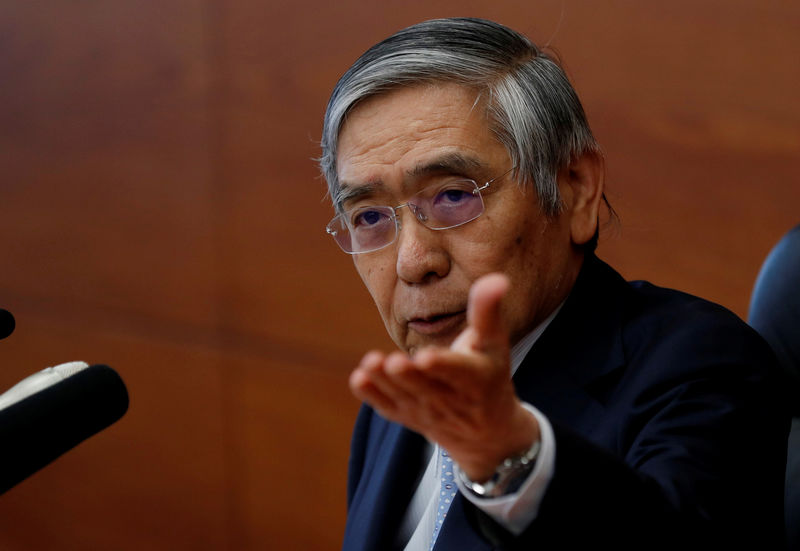By Leika Kihara
OSAKA (Reuters) - Bank of Japan Governor Haruhiko Kuroda said on Tuesday that if the central bank were to ease monetary policy further, it would aim at pushing down short- and medium-term interest rates without flattening the yield curve too much.
Kuroda said the BOJ has no preset idea on whether to ramp up stimulus at its next rate review on Oct. 30-31, suggesting that the decision will depend on market moves and the economy's resilience to overseas risks.
But he said the central bank has become more eager to top up monetary support than before due to heightening risks such as the widening fallout from the U.S.-China trade conflict.
"As risks regarding overseas economy are heightening, we need to be increasingly vigilant to the chance the overseas slowdown could affect Japan's economy and inflation," Kuroda said in a speech to business leaders in Osaka.
"We don't have any preset idea on whether to act next month. But we're more keen to ease than before since overseas risks are heightening," Kuroda later told a news conference.
In pondering additional easing, the BOJ will look not just at the benefits but the rising cost of prolonged easing such as the strain it inflicts on financial institutions' profits.
"If the BOJ were to loosen monetary policy, it needs to push down short- to medium-term interest rates," as doing so has a bigger impact in stimulating the economy than targeting the longer end of the yield curve, Kuroda said.
"If the BOJ were to lower short- and medium-term rates, it will adjust the composition of its bond buying operation as needed to prevent super-long bond yields from falling too much."
Reducing the BOJ's purchases of super-long government bonds would have a certain effect in preventing excessive falls in yields of those maturities, he added.
While Kuroda did not offer clues on what tools the BOJ could use to ramp up stimulus, his remarks suggest that deepening negative rates would be a key option if it were to act since doing so would have a direct impact on short-term yields.
Under a policy dubbed yield curve control (YCC), the BOJ pledges to guide short-term rates at -0.1% and the 10-year bond yield around 0%. It also buys risky assets to achieve its elusive 2% inflation target.
The BOJ has said it has four tools to ease: deepening negative rates, cutting the 10-year bond yield target, ramping up asset buying and accelerating the pace of money printing.
Kuroda said the BOJ should not rule out any option, including deepening negative rates, if it were to ease again.
He also said the BOJ will continue to seek ways to make YCC more sustainable given the impact years of ultra-low rates are having on financial institutions' profits.
The BOJ kept monetary policy steady last week but signaled the chance of expanding stimulus as early as its October policy meeting by issuing a stronger warning against overseas risks threatening the economy.
In determining if further action is needed, the BOJ will look at whether demand is exceeding supply, how keen companies are in raising prices and wages, as well as developments with inflation expectations, Kuroda said on Tuesday.
The BOJ will scrutinize data, assessments to be made by the bank's regional branch managers and market developments in deciding policy at the October rate review, he said.

"The situation has been changing rapidly, with investors' risk aversion abating somewhat due to expectations for progress in the U.S.-China trade negotiations," Kuroda said.